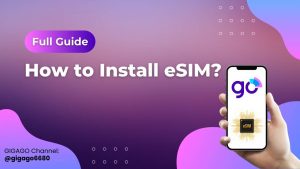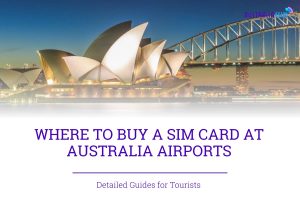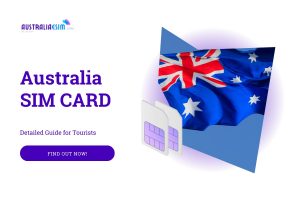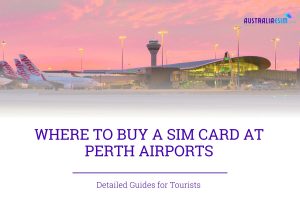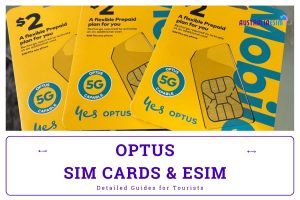Mobile Internet in Australia is important for travelers since it allows them to access important travel information, navigate, and communicate with family and friends. Using local SIM cards and eSIMs in Australia provides tourists with cost-effective access to local rates for calls, texts, and data, eliminating the need for expensive international roaming fees. This guide will help you find the optimal connectivity for your stays.

Table of Contents
I. Mobile Internet Coverage and Speed in Australia
1. Coverage of Mobile Internet in Australia

Mobile internet coverage in Australia has come a long way in recent years. The major carriers Telstra, Optus and Vodafone have all invested heavily in expanding and upgrading their 4G networks, especially in urban areas.
- Telstra: It’s Australia’s largest network provider with the widest coverage in the country. With more than 4,900 5G sites nationwide, the telco’s 5G network reaches over 99.5% of the population in Australia.
- Optus: Their 5G network covers over 99% of the population in Australia., equal to two-thirds of the country. Optus is in a leading position for the highest 5G, download performance.
- Vodafone: 5G has a more layered coverage structure. It has 85% of the population of 10 major Australian cities covered, with 1000 suburbs in these major cities where Vodafone built the 5G network.
Overall, mobile data is available to around 98-99% in cities and large population centres. For travelers and tourists, sticking to major highways and well-populated coastal areas will typically mean strong 4G connectivity.
2. Speed of Mobile Internet in Australia

The national average for mobile download speeds in Australia sits around 161.6 Mbps, ranked in 25th in the world. With 5G rollouts now underway as well, mobile broadband performance in Australia looks set to accelerate further over the coming years.
Compared to its Oceanic neighbor New Zealand, which ranks 39th globally with median mobile speeds of around 71.47 Mbps Australia has slightly higher average mobile speeds.
Our recommendations: Telstra generally offers the fastest speeds, but Optus has better coverage in some areas. Therefore, for tourists coming to Australia, use the Optus network because of its availability and transmission stability.
II. Best Ways for Tourists to Get Internet in Australia
Tourists in Australia can stay connected through free Wi-Fi, international roaming, local SIM cards, or eSIMs. Each option suits different needs, with eSIMs offering unparalleled convenience for travelers.
| Option | Pros | Cons |
|---|---|---|
| Free Wi-Fi | No cost, widely available in popular areas like airports and cafes. | Often slow, insecure, and not always accessible in remote locations. |
| International Roaming | Convenient as it uses your existing number and plan. | Expensive; roaming charges can add up quickly. |
| Local SIM Card | Affordable data plans with reliable coverage. | Requires an unlocked phone, passport for activation, and a trip to a store to purchase. |
| eSIM | Instant activation No physical card needed, can be set up before arriving in Australia. | Need eSIM-compatible devices. |
For tourists, eSIMs offer the most convenient and flexible solution to stay connected in Australia. They eliminate the hassle of finding a store and waiting in line and can be activated instantly before your trip. Travelers can land in Australia with reliable internet already set up, making eSIMs the ultimate choice for those who value ease and efficiency.
Plans that may interest you
III. Budgeting for Mobile Data Costs in Australia
Staying connected in Australia is necessary for tourists coming here. Besides, estimating data usage also needs to be considered by you depending on the time you are here as well as your usage needs.
| Short-term trip | Long-term trip | |
| Package plans/data | 3GB – 6GB | 10GB – 20 GB+ |
| Price range | $6 – $60 | $12 – $140 + |
| Validity | 3 – 7 days | 7 – 30 days |
Australia eSIM offers a variety of plans with options ranging from 3 to 30 days. Data packages vary from 3GB to 20GB with prices from $6.00 to $141.50.
| Short trip | Long trip | |
| Data package | 3GB | 20GB + |
| Validity | 7 days | 30 days |
| Price | $13 | $50 |
Tips for Saving on Mobile Data:
- Utilize free Wi-Fi: Many public locations usually provide free Wi-Fi. Use it to perform over-data usage to help you avoid excessive data.
- Download maps offline: Have Google Maps, which is the offline map and other navigation apps available for download to save data when walking.
- Manage data usage: Turn off automatic updates for applications that you don’t use daily and, otherwise, refresh background data for them.
IV. Best Mobile Operators in Australia
Australia has three major mobile operators—Telstra, Optus, and Vodafone—each offering distinct benefits for tourists.
| Provider | Price range | Data (GB)/Validity | Features | Pros | Cons |
| Telstra | $12 – $160 | 3GB – 110GB (7 – 30 days) | Most extensive network coverage | Fastest network and speed. Variety packages | High price |
| Optus | $10 – $45 | 5GB – 80GB (7-28 days) | Strong national coverage | Reasonable prices Stable network Diverse plans | Limited network and speed in some rural places |
| Vodafone | $30 – $50 | 40GB – 80GB (28 days) | Good coverage in major cities | Cheap prices Network stable in rural areas | Network speeds are unstable in many areas |
For tourists visiting Australia, Optus stands out as the most balanced choice among the major mobile operators. While Telstra offers unparalleled network coverage and the fastest speeds, its plans are often on the expensive side, making it better suited for those venturing into remote areas. Vodafone, on the other hand, provides affordable options with decent city coverage but lacks reliability in rural regions.
V. FAQs about Mobile Internet in Australia
Are eSIMs reliable for traveling in Australia?
Yes, eSIMs are a reliable and convenient option for travelers in Australia. Australia-eSIM.com offers plans with excellent coverage and fast activation, making them ideal for both city and remote travels.
I’m a budget-conscious traveler. How is this service the least expensive?
Typically, buying a local SIM card or eSIM is the most affordable option; it provides telecommunications service providers with very good opportunities to sell various data packages at attractive prices.
It is difficult for me to figure out how much data I require. What if I‘m just low-supplied?
A lot of plans would be featuring data top-up, that is you could charge more data if it has run out.
Are users of mobile cellular networks aware of all the ways to reduce mobile data usage?
Free Wi-fi is your best friend! Download offline maps for proper dining and also learn to control background app refresh to save data.
Can I get a pocket wifi rental in Australia?
Yes, you can easily rent a pocket wifi device in Australia for your travels.
VI. Conclusion
In conclusion, choosing the right mobile data option when traveling in Australia comes down to assessing your individual needs, budget, and travel plans. For flexibility and simplicity, local SIM cards or eSIM from Australia-esim.com are suitable choices to help you have an uninterrupted experience as well as a convenient connection.


